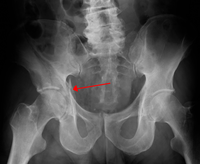
Photo from wikipedia
OBJECTIVE The aim: To conduct a thorough analysis of the surgical approach features in femoral head fractures combined with acetabulum posterior wall fractures; to analyze these patients' treatment results 12-36… Click to show full abstract
OBJECTIVE The aim: To conduct a thorough analysis of the surgical approach features in femoral head fractures combined with acetabulum posterior wall fractures; to analyze these patients' treatment results 12-36 months after the surgery; to determine the criteria affecting the satisfactory treatment results achievement in these injuries. PATIENTS AND METHODS Materials and methods: The surgical treatment results were evaluated 13 and 36 months after the surgery. The retrospective analysis included 21 patients (17 men and 4 women) with femoral head fractures combined with the acetabulum posterior wall fractures. Pipkin and Brumback classifications were used to classify the fractures. RESULTS Results: The results of acetabulum posterior wall fractures delayed treatment are significantly different to the ones treated with early osteosynthesis. The reasons for that are difficulties in anatomical repositioning, femoral head malnutrition due to its displacement or chronic subluxation, reduced blood supply to the fragments due to surgical manipulations during the approach. Thus, according to Matta criteria anatomical reposition of the fragments was achieved in 19 (90.5%) cases, imperfect reposition in 1 (4.8%) case, unsatisfactory reposition - in 1 (4.8%) patient. The treatment results' improvement after 3 years occurred due to hip joint replacement in 5 (23.8%) patients. CONCLUSION Conclusions: The treatment results of femoral head fractures with acetabulum posterior wall fractures depends on the type of fracture, concomitant injuries, the timing, and method of removing the femoral head dislocation, and the surgical treatment method.
Journal Title: Wiadomosci lekarskie
Year Published: 2022
Link to full text (if available)
Share on Social Media: Sign Up to like & get
recommendations!